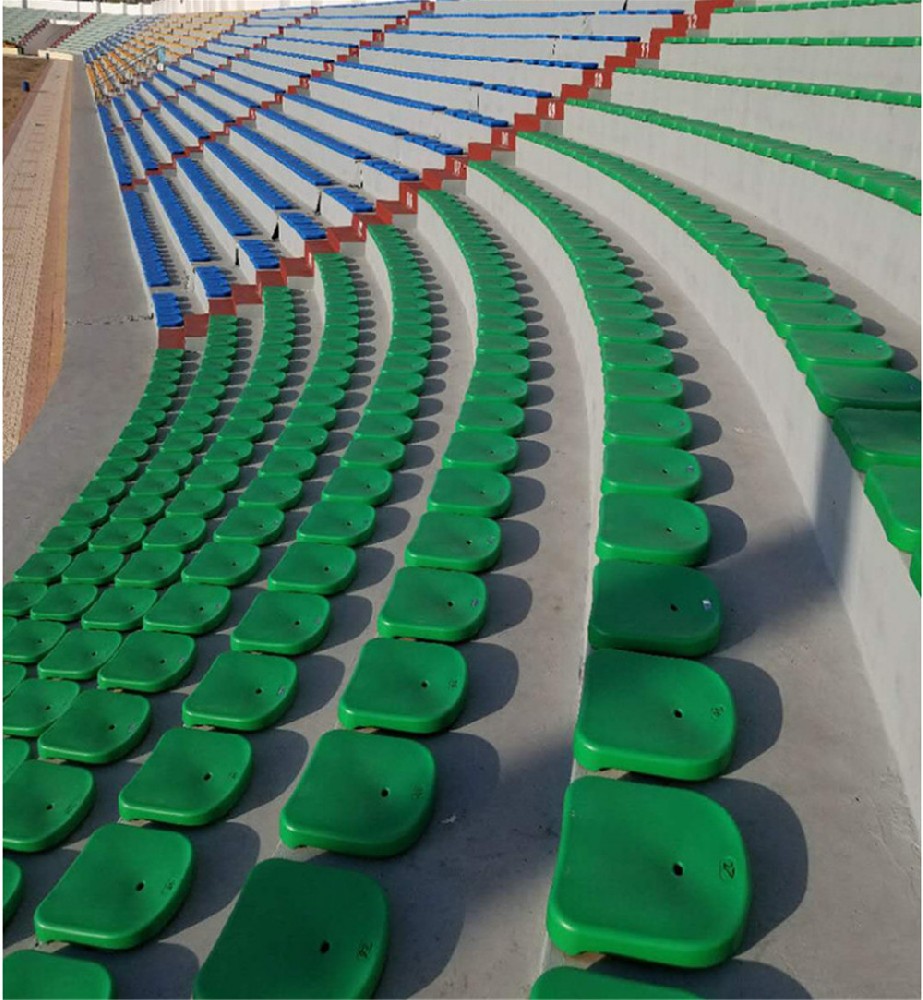What is the place where spectators sit in a stadium called? Types of stadium seats
The area where spectators sit in a stadium is collectively referred to as the auditorium (or stands). These seats can be categorized into various types based on design, functionality, and viewing experience. Cangzhou Haoran Sports Equipment Co., Ltd., a China-based manufacturer of stands and seats in Hebei Province, provides the following key classifications and characteristics of stadium seating:

1. Classification by Location
Lower Tier
Location: The area closest to the playing field, typically divided into front, middle, and back rows.
Features:
The viewing angle is nearly horizontal, suitable for close-up viewing of athletes' movements (e.g., in football and track and field).
Front-row seats may be too close, limiting the viewing angle (e.g., needing to look up to see a high ball).
Prices are generally higher, especially for areas near the center line or the benches.
Middle Tier
Location: Located between the lower and top tiers, at a moderate height.
Features:
Balances viewing distance and viewing angle, allowing for clear observation of athlete details while also providing a bird's-eye view of the entire field.
Prices are moderate, making it one of the most cost-effective options. Upper Tier/Nosebleed Seats
Location: Located at the highest point of the stadium, offering a wide view but further from the field.
Features:
Suitable for observing the overall rhythm of a match (e.g., football tactical setups, track and field relays), but with less detail visibility.
Usually the lowest price, suitable for those on a budget or seeking ambiance.
Some stadiums have rooftop awnings or windbreaks.
II. Classification by Function
General Admission
Features: No fixed seat numbers, first-come, first-served, typically located in the upper tier or wing areas.
Suitable for: Small events, training matches, or spectators on a budget.
Assigned Seats
Features: Each seat is uniquely numbered, and spectators are assigned according to their ticket.
Classifications:
Economy Seats: Located in the upper tier or corners, with lower prices.
Premium Seats: Located near the center line, the bench, or the tunnel, with higher prices.
Private Suites
Location: Typically located in the middle tier or at the edge of the upper tier, separate from the public stands. Features:
Equipped with a sofa, dining table, private bathroom, and TV, these seats offer a private viewing experience.
Suitable for corporate receptions, family gatherings, or high-end spectators, they are priced higher.
VIP Seats
Location: Located on the lower or middle floors, near the core area of the field (e.g., the midline in football, the sidelines in basketball).
Features:
Offering exclusive access, complimentary meals, and souvenirs, these seats provide an excellent viewing experience.
Often included in high-end ticket packages, such as season passes.
III. Classification by Viewing Experience
Center Seats
Location: Facing the midline of the field, offering the most balanced viewing angle.
Suitable for events requiring a comprehensive view, such as football and rugby.
Corner Seats
Location: Seats located in the four corners of the stadium.
Features:
Enables viewing of specific details (e.g., corner kick tactics) while also providing a partial view of the entire field.
Affordable, suitable for tactical enthusiasts.
Behind-the-Goal Seats
Location: Located in the stands behind the goal. Features:
Great for catching the moment of a goal and the celebrations of players, but the viewing angle is limited.
During football matches, the net may obstruct the viewing experience.
Courtside/Pitchside Seats
Location: Close to the edge of the playing field (e.g., basketball courtside, near the technical area of a football field).
Features:
Get up close and personal with the players, and you might even be caught on camera.
Prices are very high, usually reserved for celebrities or sponsors.
IV. Classification by Special Needs
Accessible Seats
Location: On the lower or middle levels, near the exits, allowing for wheelchair access.
Features:
Equipped with accessible access, dedicated restrooms, and accompanying seats.
Limited availability; reservations are required.
Family Section
Location: Typically located on the top floor or in the wings, away from the bustling areas.
Features:
Alcohol and noise are prohibited, making it suitable for spectators with children.
Some stadiums offer children's activity areas or family packages. Student Section
Location: Top floor or corner area, home to a large student audience.
Features:
Low ticket prices, lively atmosphere, and frequent group cheering activities.
Student ID required for ticket purchase.
Supporters' Section
Location: Lower or middle floor area near the goal.
Features:
Gathering of enthusiastic fans, where standing, cheering, and flags are permitted.
Specific rules apply (e.g., no offensive items).
V. Seating Recommendations
Budget-conscious: Choose top floor economy seats or the student section.
Seeking atmosphere: Choose the supporters' section or pitchside seating (must be able to accommodate a noisy environment).
Family: Accessible seating or the family section.
Business reception: Boxes or VIP seating.
Tactical analysis: Center seats or corner seats.
Summary: Stadium seating offers a variety of seating options, from top floor economy seats to pitchside VIPs, from enthusiastic supporters' sections to quiet family areas, to meet the needs of every spectator. When choosing seats, you need to consider your budget, viewing preferences, event type, and special needs to get the best viewing experience.
padel court,Gymnastic mats, basketball racks, volleyball posts, tennis dwellings, badminton posts, adult gymnastic equipment, parallel bars, horizontal bars, uneven bars, gymnastic rings, balance beams, saddles, hydraulic referee tables, table tennis tables, outdoor fitness equipment, garden fitness equipment
Website:
http://www.hransports.com/article/314.html